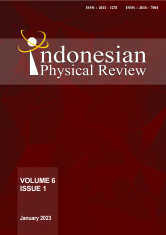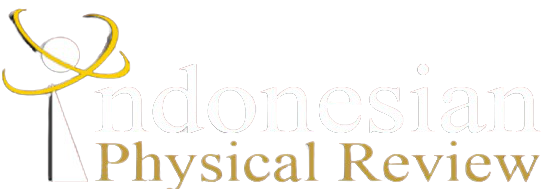SLIDING PLANE IDENTIFICATION FOR LANDSLIDE HAZARD MITIGATION WITH RESISTIVITY TOMOGRAPHY METHOD
DOI:
10.29303/ipr.v6i1.181Downloads
Abstract
Pidada area, Panjang sub-district, Bandar Lampung city, located on Barisan Hill complex, has been affected by the Sumatran fault movement and the Lampung-Panjang fault so that the morphological condition is hilly with steep slopes, which causes the risk of natural disasters such as landslides. In this article, the identification of subsurface rock lithology and sliding plane in the landslide-prone zone is carried out using the Wenner-Schlumberger configuration geoelectric method. Based on the Wenner-Schlumberger configuration, the top layer has lithology clay tuff and sandy tuff, which predicted a weathered rock with a resistivity of 1 - 133 ohm.m. Coarse-grained tuff and fine-grained tuff with resistivity values of 135 - 250 ohm.m in the middle. The bottom layer has a resistivity of more than 250 ohm.m, that predicted to have a lithology breccia (igneous rock) Tarahan Formation. The sandy clay layer (81 - 90 ohm.m) predict as a sliding plane in this area at depths of 8.2 to 16 m. The type of landslide developed in the research area is a crawling soil landslide with very steep slope characteristics (80 – 350).Keywords:
Electrical resistivity tomography Landslide Pidada Hazard mitigationReferences
A. Zamroni, A. C. Kurniati, and H. N. E. Prasetya, “The assessment of landslides disaster mitigation in Java Island, Indonesia: a review,†Journal of Geoscience, Engineering, Environment, and Technology, vol. 5, no. 3, pp. 139–144, 2020, doi: 10.25299/jgeet.2020.5.3.4676.
C. N. Poland and P. Zientara, “Advancing Culture of Living with Landslides,†Advancing Culture of Living with Landslides, 2017, doi: 10.1007/978-3-319-53487-9.
W. C. Samsul Arifin, Ita Carolina, “Implementasi Penginderaan Jauh dan SIG untuk Inventarisasi Daerah Rawan Bencana Longsor,†Jurnal Penginderaan Jauh dan Pengolahan data Citra Digital, vol. 3, pp. 77–86, 2006, [Online]. Available: http://www.jurnal.lapan.go.id/index.php/jurnal_inderaja
I. N. P. Permanasari, V. L. Ipmawan, and E. Khairuman, “Determination of Slip Surface Using 2D Geoelectric Resistivity Method and Laboratory Analysis for Landslide Prone Area Pesawaran, Lampung,†IOP Conf Ser Earth Environ Sci, vol. 537, no. 1, 2020, doi: 10.1088/1755-1315/537/1/012011.
A. Hojat et al., “Geoelectrical characterization and monitoring of slopes on a rainfall-triggered landslide simulator,†J Appl Geophy, vol. 170, p. 103844, 2019, doi: 10.1016/j.jappgeo.2019.103844.
R. Mulyasari, H. W. Utama, and N. Haerudin, “Geomorphology study on the Bandar Lampung Capital City for recommendation of development area,†IOP Conf Ser Earth Environ Sci, vol. 279, no. 1, p. 12026, 2019, doi: 10.1088/1755-1315/279/1/012026.
R. Mulyasari, N. Haerudin, Karyanto, I. G. B. Darmawan, and Y. Arifianti, “Zonasi Area Potensi Gerakan Massa di Sepanjang Sesar Lampung-Panjang Kota Bandar Lampung,†in Prosiding Semnas SINTA FT, 2018, vol. 1, no. 1, pp. 2655–2914.
R. Mulyasari et al., “Aplikasi Metode Geolistrik Resistivitas Untuk Analisis Bidang Gelincir Dan Studi Karakteristik Longsoran Di Jalan Raya Suban Bandar Lampung,†Jurnal Geofisika Eksplorasi, vol. 6, no. 1, pp. 66–76, 2020, doi: 10.23960/jge.v6i1.61.
A. Sigdel and R. K. Adhikari, “Application of Electrical Resistivity Tomography (ERT) survey for investigation of the landslide: a case study from Taprang landslide, Kaski district, west-central Nepal,†Journal of Nepal Geological Society, vol. 60, pp. 103–115, 2020, doi: 10.3126/jngs.v60i0.31261.
K. ÅuszczyÅ„ska, “Application of dendrochronology and electrical resistivity tomography for studies on landslide activity (Southern Poland),†AIP Conf Proc, vol. 2186, no. December, 2019, doi: 10.1063/1.5138036.
S. Carpentier, M. Konz, R. Fischer, G. Anagnostopoulos, K. Meusburger, and K. Schoeck, “Geophysical imaging of shallow subsurface topography and its implication for shallow landslide susceptibility in the Urseren Valley, Switzerland,†J Appl Geophy, vol. 83, pp. 46–56, 2012, doi: 10.1016/j.jappgeo.2012.05.001.
W. M. Telford, L. P. Geldart, and R. E. Sheriff, Applied Geophysics: Second Edition. Cambridge University Press, 1990.
M. H. Loke, “Tutorial: 2-D and 3-D Electrical Imaging Surveys, 2004 Revised Edition,†2004.
M. H. Loke, “Electrical Imaging Surveys for Environmental and Engineering Studies. A Practical Guide to 2-D and 3-D Surveys,†RES2DINV Manual, IRIS Instruments, 2001, [Online]. Available: www.iris-instruments.com
S. A. Mangga, Amirudin, T. Suwarti, S. Gafoer, and Sidarta, “Peta Geologi Lembar Tanjungkarang, Sumatera, skala 1:250.000,†1993.
P. O. Falae, D. P. Kanungo, P. K. S. Chauhan, and R. K. Dash, “Electrical resistivity tomography (ERT) based subsurface characterisation of Pakhi Landslide, Garhwal Himalayas, India,†Environ Earth Sci, vol. 78, no. 14, 2019, doi: 10.1007/s12665-019-8430-x.
License

This work is licensed under a Creative Commons Attribution-NonCommercial-ShareAlike 4.0 International License.
Authors who publish with Indonesian Physical Review Journal, agree to the following terms:
- Authors retain copyright and grant the journal right of first publication with the work simultaneously licensed under a Creative Commons Attribution-ShareAlike 4.0 International Licence (CC BY SA-4.0). This license allows authors to use all articles, data sets, graphics, and appendices in data mining applications, search engines, web sites, blogs, and other platforms by providing an appropriate reference. The journal allows the author(s) to hold the copyright without restrictions and will retain publishing rights without restrictions.
- Authors are able to enter into separate, additional contractual arrangements for the non-exclusive distribution of the journal's published version of the work (e.g., post it to an institutional repository or publish it in a book), with an acknowledgment of its initial publication in Indonesian Physical Review Journal.
- Authors are permitted and encouraged to post their work online (e.g., in institutional repositories or on their website) prior to and during the submission process, as it can lead to productive exchanges, as well as earlier and greater citation of published work (See The Effect of Open Access).





